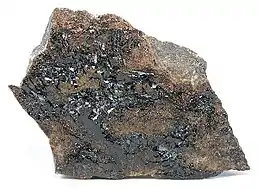Hisingerite
Hisingerite is an iron(III) phyllosilicate mineral with formula Fe3+2Si2O5(OH)4·2H2O. A black or dark brown, lustrous secondary mineral, it is formed by the weathering or hydrothermal alteration of other iron silicate and sulfide minerals.[1]
| Hisingerite | |
|---|---|
 Crystallized plates of reddish-brown, silver metallic-lustre hisingerite crystals | |
| General | |
| Category | Silicate mineral |
| Formula (repeating unit) | Fe3+2Si2O5(OH)4·2H2O |
| Strunz classification | 9.ED.10 |
| Crystal system | Monoclinic Unknown space group |
| Unit cell | a = 5.4, b = 9.03 c = 14.99 [Å]; β = 98.32°; Z = 4 |
| Identification | |
| Color | Black, brownish-black |
| Crystal habit | Massive, compact; acicular, may be minutely spherical. |
| Cleavage | None |
| Fracture | Conchoidal |
| Tenacity | Brittle |
| Mohs scale hardness | 2.5 - 3.0 |
| Luster | Vitreous, resinous, greasy |
| Streak | Yellowish brown, green |
| Diaphaneity | Transparent to translucent |
| Specific gravity | 2.43 - 2.67 |
| Optical properties | Biaxial (-) |
| Refractive index | nα = 1.715 nγ = 1.730 |
| Birefringence | δ = 0.015 |
| References | [1][2][3] |
It was first described in 1828 for an occurrence in Riddarhyttan, Vastmanland, Sweden. It was named after Wilhelm Hisinger (1766–1852), a Swedish chemist.[3]
There are also aluminian hisingerite variety in which one of the iron atoms is replaced by aluminium and chrome-alumina-hisingerite variety in which chromium substitutes for iron.[2]
References
This article is issued from Wikipedia. The text is licensed under Creative Commons - Attribution - Sharealike. Additional terms may apply for the media files.